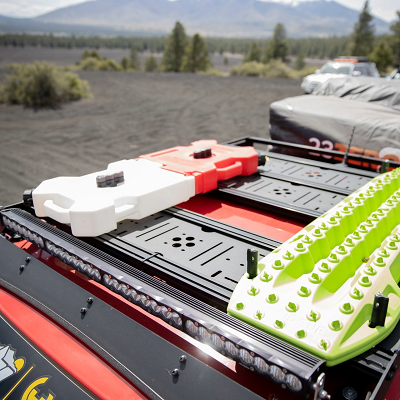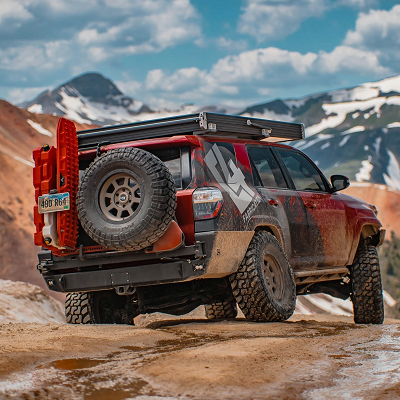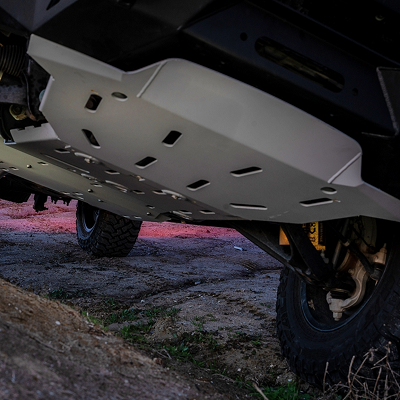Your Cart is Empty

Shop By Vehicle:

Roof Racks
Bed Racks

Front Bumpers

Rear Bumpers

Rock Sliders

Skid Plates
April 05, 2025 11 min read
If you've spent any time in any off-road community, you've likely heard the term "long travel" thrown around with a mix of reverence and excitement. It's one of those Toyota Tacoma accessories that separates the casual off-roaders from the dedicated enthusiasts, and for good reason.

I've had the chance to build, test, and wheel several Tacomas with long travel systems over the years, from desert racing setups to rock-crawling rigs. What I've learned is that long travel kits are incredible for specific scenarios but definitely not for everyone, despite what Instagram might lead you to believe.
In this guide, I'll break down exactly what long travel kits do, who they're actually meant for, and help you decide if this significant investment makes sense for your particular Tacoma build and driving habits. I will also recommend some of the top long travel kits on the market for the Tacoma.
A long travel suspension system redesigns your Tacoma's front suspension to allow for significantly increased wheel travel – typically 2-4 inches more than stock suspension. This is achieved by replacing upper and lower control arms with longer, stronger components and installing specially designed coilovers, bump stops, and supporting modifications.
The goal isn't just lifting the truck (though that does happen); it's creating a suspension system that can absorb bigger impacts at higher speeds while keeping your tires in contact with challenging terrain.

Key components of a typical long travel kit include:
Unlike simpler lift kits that primarily increase ride height, long travel systems fundamentally change how your suspension functions. They're engineered to deliver maximum performance in extreme off-road conditions, particularly at higher speeds over rough terrain.
The primary benefit of a long travel kit is right in the name – substantially increased wheel travel. While stock Tacomas typically offer about 7-8 inches of front wheel travel, quality long travel systems can deliver 11-13+ inches of travel.
This additional movement allows the suspension to absorb massive impacts and terrain variations that would stop or damage a stock suspension.
The ability to keep your tires in contact with the ground through extreme terrain variations is a game-changer for serious off-road performance.
Long travel kits truly shine in specific off-road scenarios:
A long-travel-equipped Tacoma could comfortably run 40-50 mph on washboard roads with stock trucks creeping along at 15-20 mph. The difference in capability is dramatic in the right environment.

Long travel kits typically increase ground clearance in two ways:
This additional clearance, combined with the increased articulation, means you're less likely to hang up on obstacles or drag your undercarriage over rough terrain.
Quality long travel systems aren't just about absorbing bigger hits – they're engineered to provide better overall control in challenging conditions. Better dampening, more precisely tuned spring rates, and improved geometry can give you:
The difference is particularly noticeable when pushing hard through rough sections. Where a stock truck might bounce unpredictably, a well-tuned long travel setup keeps the chassis more composed and the tires more consistently in contact with the terrain.
Aesthetics matter to many Tacoma owners. Long travel kits deliver a distinctly aggressive stance with their wider track width and typically increased ride height. The flared fiberglass fenders, often required to accommodate the wider stance, adds to the purpose-built look that sets these trucks apart from standard lifted Tacomas.

There's no way around it – long travel systems represent one of the most significant investments you can make in your Tacoma's suspension. Quality long travel kits generally start around $3,000-4,000 for just the components. Then you also need to factor in:
A complete long travel build can easily exceed $7,000-10,000. That's a substantial investment that needs to be justified by your actual usage and needs.
"I've seen many rush into long travel systems before they've even maxed out the capabilities of their current suspension. This often results in significant expense for performance benefits they never fully utilize."
Installing a long travel kit is not a weekend DIY project for most enthusiasts. It requires:
Most quality installations are performed by specialized shops that have experience working on off-road rigs. The complexity extends beyond the suspension itself – you'll likely need to address steering geometry, brake line length, CV axle angles, and numerous other details to create a safe, functional system.
Long travel systems introduce more complexity and stress into your suspension system, which inevitably leads to increased maintenance requirements:
I've found that long travel Tacomas typically require suspension service at least twice as frequently as stock or moderately lifted trucks.
While long travel systems excel off-road, they often introduce compromises for daily driving:
These aren't necessarily deal-breakers, but they're important considerations if your Tacoma serves as both daily transportation and weekend warrior.
The increased width of long travel suspension typically requires wider fenders or entirely new fiberglass front ends to accommodate the extended suspension travel and prevent tire rubbing. This means:
These modifications also further separate your truck from stock, which if it matters to you, may affect resale value.
Long travel systems make the most sense for specific types of Tacoma owners:
Desert runners and high-speed off-roaders: If your off-road style involves maintaining speed through rough terrain, long travel provides substantial benefits that justify the investment.
Competitive off-road racers: For those participating in events like desert races, rock racing, or similar competitions, long travel can provide a genuine competitive advantage.
Purpose-built off-road rigs: If your Tacoma is a dedicated off-road vehicle rather than daily transportation, the on-road compromises become less relevant.
Enthusiasts who have maxed out other mods: If you've already installed quality mid-travel suspension and still find its performance limiting for your driving style, long travel is the logical next step.
I've found that the happiest long travel Tacoma owners are those who regularly use their trucks in the environments where these systems excel. If you're spending multiple weekends a month in the desert or on rough trails at speed, you'll appreciate the benefits.
On the other hand, long travel systems are often overkill or impractical for:
Daily drivers with occasional off-road use: If your Tacoma spends 90% of its time commuting and only occasionally sees mild to moderate trails, the investment in long travel is difficult to justify.
Budget-conscious builders: The substantial cost of long travel could instead buy several other meaningful upgrades that might better serve your overall goals.
Technical crawling specialists: If your off-road focus is slow-speed rock crawling or technical trail navigation, other suspension setups might actually perform better for your needs.
Those who haven't maxed out simpler systems: If you haven't yet explored the capabilities of quality mid-travel suspension with good shocks, you might be surprised at how capable these more moderate systems can be.
Owners in areas with strict vehicle modification laws: Some states have increasingly strict regulations about track width, fender coverage, and suspension modifications.
If you're seeking improved off-road performance but aren't sure long travel is right for you, consider these alternatives:
Quality mid-travel suspension: Systems offering 10-25% more travel than stock with high-performance shocks can provide substantial improvement without the extreme cost and complexity of long travel. Out of the box options from Dirt King are great. Also shocks from Fox, King, or Icon with appropriate upper control arms can transform your Tacoma's capability while maintaining better daily drivability.
Upgraded shocks with stock geometry: Simply upgrading to quality coilovers with remote reservoirs while maintaining stock suspension geometry can dramatically improve performance in most scenarios weekend warriors encounter.
UCAs with stock-length travel: Aftermarket upper control arms with better ball joints and improved geometry can enhance wheel travel and durability without the extreme changes of a long travel system.
Rear suspension focus: Many Tacoma owners overlook the importance of rear suspension. Quality leaf packs and proper shocks can improve overall capability significantly at a lower cost than front long travel.
I've found that a quality 2.5" Coilover and aftermarket UCAs provides about 80% of the off-road capability I need while maintaining excellent on-road manners and reasonable maintenance requirements.
After years of building, testing, and wheeling Tacomas with various suspension setups, my verdict on long travel comes down to this: it's absolutely worth it for the right person with the right needs, but unnecessary and potentially wasteful for many enthusiasts who are drawn to it primarily for the aesthetics or status.
Long travel makes sense when:
It's probably not worth it when:
The most successful off-road builds I've seen aren't necessarily the ones with the most extreme modifications – they're the ones that are thoughtfully matched to the owner's actual driving habits and needs. A well-chosen mid-travel system that gets used regularly will deliver more enjoyment than a long travel system that's rarely pushed to its potential.
At Truck Brigade, we've helped hundreds of Tacoma owners navigate these decisions, and our philosophy remains consistent: build for how you actually use your truck, not how you imagine using it or how you want it to look in photos
For the right person, a long travel kit can be a great option. If that is you, you might be wondering what the best kits are. You cannot go wrong with kits from Camburg and Total Chaos who have perfected their long travel kits for decades. Below are some of our favorites.
TheCamburg Trail Series Long Travel Kit is designed for Tacoma owners who want to elevate their off-road capability without going full race-spec. Built for aggressive trail use and weekend adventuring, this kit delivers a significant increase in wheel travel and overall suspension performance while maintaining solid daily drivability. It features Camburg's precision-engineered upper and lower control arms, extended axles, and high-quality uniballs to improve articulation and durability. Ideal for overlanders and recreational off-roaders, the Trail Series offers a great balance between capability, comfort, and cost.

If you’re looking to transform your Tacoma into a serious off-road machine, theCamburg Race Series Long Travel Kit is a top-tier option. Designed for high-speed desert performance and competitive use, this kit incorporates race-proven technology including boxed lower control arms, billet uniball upper arms, and extended-length axles for maximum travel and strength. With increased suspension geometry and durability to handle harsh conditions, the Race Series is engineered for those who demand peak performance. It's a premium choice for off-roaders who don’t compromise.

The Total Chaos Expedition Series Long Travel Kit is purpose-built for off-road explorers who need enhanced suspension travel and reliability without sacrificing daily drive comfort. Engineered with overlanding and long-distance trail runs in mind, this kit improves ground clearance, wheel travel, and ride quality. It includes extended chromoly upper and lower control arms, extended axles, and reinforced components to handle moderate to intense off-road terrain. The Expedition Series is ideal for Tacoma owners looking to push their truck further off the grid with confidence and comfort.
For hardcore enthusiasts chasing maximum performance, the Total Chaos Race Series Long Travel Kit is the go-to choice. This high-end system is designed for desert racing and extreme terrain, offering unparalleled suspension articulation and strength. Featuring fully-fabricated lower control arms, race-style upper arms, heavy-duty steering upgrades, and the ability to run coilovers and bypass shocks, this kit is built to dominate. It’s not intended for casual use—this is a pro-level setup for those who live for high-speed off-road action and need their Tacoma to match.
How much wheel travel do long travel kits actually add to a Tacoma?
Quality long travel kits typically increase front wheel travel by 2-4 inches over stock, bringing total travel from the stock 7-8 inches to approximately 11-13+ inches. This significant increase is what allows the suspension to absorb major impacts and terrain variations at higher speeds.
Will installing a long travel kit void my Tacoma's warranty?
Yes, long travel kits will almost certainly affect your warranty coverage for the suspension system and potentially related components. While the Magnuson-Moss Warranty Act prevents manufacturers from voiding the entire vehicle warranty, Toyota can deny warranty claims for components directly affected by or damaged as a result of these significant modifications.
Can I return to stock after installing a long travel system?
Technically yes, but it's complicated and potentially expensive. Long travel installations often involve permanent modifications like cutting or drilling, and may affect other components like steering and braking systems. Budget for significant labor costs if you think you might want to revert to stock in the future.
Do I need to regear my Tacoma when installing a long travel kit?
Long travel itself doesn't necessarily require regearing, but most long travel builds also include larger tires that do affect gearing. For tires 33" and under, regearing is helpful but optional. For 35"+ tires, regearing becomes strongly recommended to restore proper acceleration, drivability, and transmission performance.
Comments will be approved before showing up.
Sign up to get the latest on sales, new releases and more …